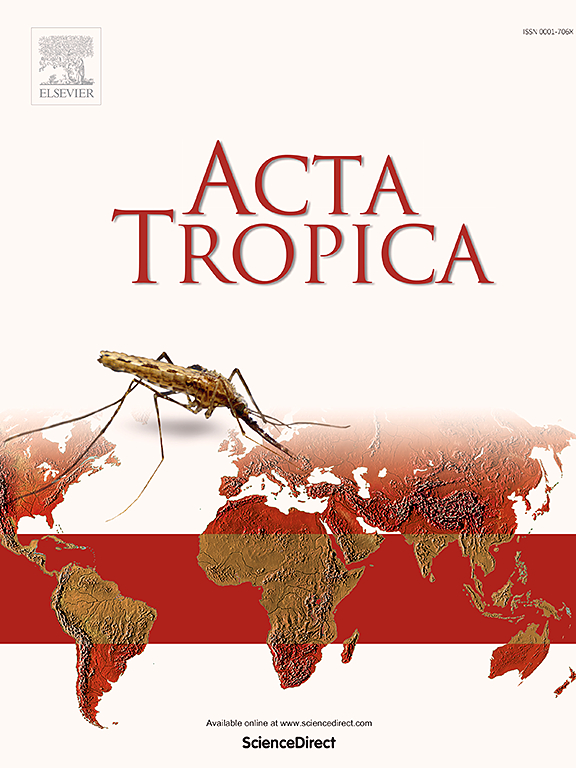IF 2.1
3区 医学
Q2 PARASITOLOGY
引用次数: 0
摘要
人肝吸虫是主要食源性吸虫寄生虫,主要分布在湄公河下游流域(东南亚)和鄂额尔齐斯盆地(俄罗斯联邦西西伯利亚南部)。这些寄生虫总共感染了1400多万人,估计有3亿人面临感染风险。它们的传播周期包括双螺和鲤科鱼分别作为第一和第二中间宿主,人类和其他食鱼哺乳动物作为最终宿主。这些吸虫的地理分布由特定的Bithynia物种所决定:siamb.s、goniomphalos b.s和B. funiculata为O. viverrini,以及B. troschelii、B. leachi和B. inflata为O. felineus。气候变化通过影响寄生虫的生存、宿主生物学和环境条件直接影响肝吸虫的传播。双螺对温度高度敏感,而弧菌的传播明显依赖于温度,温度升高1℃,感染几率增加5.4%。温度超过30℃会降低子宫颈存活率和传染性。在西伯利亚西部,适宜狐尾弓形虫传播的水温从+15°C开始,较高的温度导致蜗牛感染率增加,而永久冻土区完全没有双螺。政府间气候变化专门委员会(IPCC)的预测表明,北亚的变暖将超过全球平均水平(影响到O. felineus),而东南亚的变暖将接近全球平均水平(影响到O. viverrini)。这些趋势表明,气候变化对西伯利亚狐尾疟传播的影响可能比对东南亚狐尾疟传播的影响更为明显。本文深入讨论了血吸虫生物学和温度对蜗牛生长、尾蚴释放、存活、感染和呼吸的影响,强调了全球变暖如何影响这些肝吸虫的传播动力学。本文章由计算机程序翻译,如有差异,请以英文原文为准。
Potential impact of climate change on Opisthorchis viverrini and Opisthorchis felineus transmission in Eurasia
Human liver flukes of the family Opisthorchiidae, particularly Opisthorchis viverrini and Opisthorchis felineus, are major foodborne trematode parasites endemic to the Lower Mekong River Basin (Southeast Asia) and the Ob-Irtysh Basins (southern Western Siberia, Russian Federation), respectively. Together, these parasites infect over 14 million people, with an estimated 300 million at risk. Their transmission cycles involve Bithynia snails and Cyprinidae fish as first and second intermediate hosts, respectively, with humans and other fish-eating mammals serving as definitive hosts. The geographical distribution of these flukes is shaped by specific Bithynia species: B. siamensis, B. s. goniomphalos, and B. funiculata for O. viverrini, and B. troschelii, B. leachi, and B. inflata for O. felineus. Climate change directly influences liver fluke transmission by affecting parasite survival, host biology, and environmental conditions. Bithynia snails are highly temperature-sensitive, and O. viverrini transmission is notably temperature-dependent, with a 1 °C increase raising infection odds by 5.4 %. Temperatures exceeding 30 °C reduce cercarial survival and infectivity. In Western Siberia, favorable water temperatures for O. felineus transmission start at +15 °C, with higher temperatures leading to an increased infection rate in snails while permafrost regions lack Bithynia snails entirely. Projections from the Intergovernmental Panel on Climate Change (IPCC) indicate that warming will exceed the global average in northern Asia (affecting O. felineus) and approach the global average in Southeast Asia (impacting O. viverrini). These trends suggest that climate change may have a more pronounced impact on O. felineus transmission in Siberia than on O. viverrini transmission in Southeast Asia. This review provides an in-depth discussion of Bithynia biology and the effects of temperature on snail growth, cercarial release, survival, infection, and aestivation, emphasizing how global warming could influence the transmission dynamics of these liver flukes.
求助全文
通过发布文献求助,成功后即可免费获取论文全文。
去求助
来源期刊

Acta tropica
医学-寄生虫学
CiteScore
5.40
自引率
11.10%
发文量
383
审稿时长
37 days
期刊介绍:
Acta Tropica, is an international journal on infectious diseases that covers public health sciences and biomedical research with particular emphasis on topics relevant to human and animal health in the tropics and the subtropics.
 求助内容:
求助内容: 应助结果提醒方式:
应助结果提醒方式:


